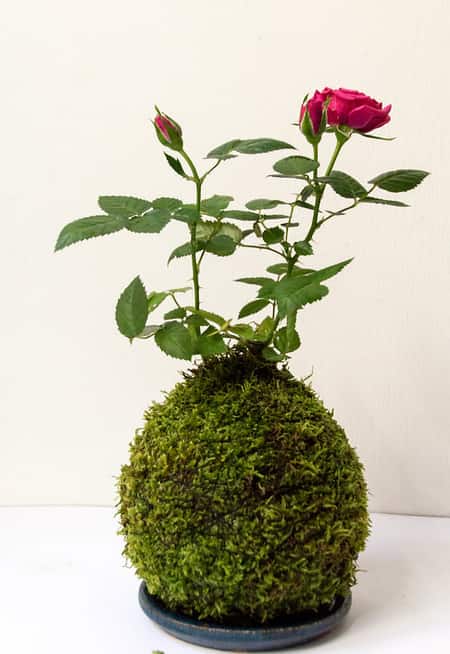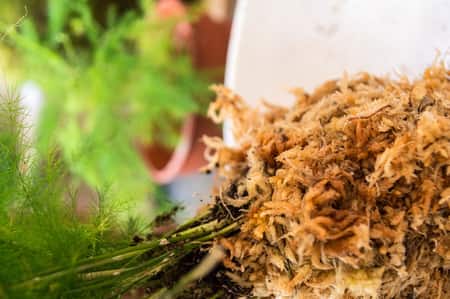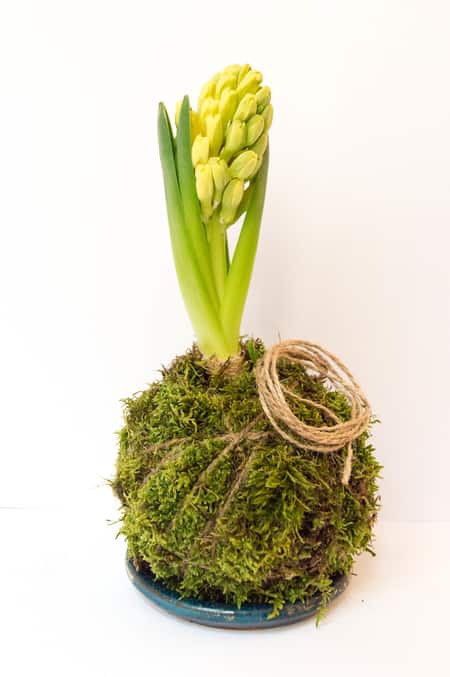Orchid Kokedamas are unique way of displaying floral designs. If you haven’t heard of Kokedama before, you’re probably wondering what that is.
Kokedama (苔玉) is a Japanese term for “moss ball”;
Koke means “moss: and dama means “ball”.
Kokedamas actually are a sub-category inside the bonsai group, initially called the “poor man’s bonsai”. Their popularity grew instantly, not from being singled out, but because their stunning design truly captures the eye.
From what was only a Japanese tradition, now conquered the world. They weren’t exclusive to orchids, either. Kokedamas can be created with any houseplant, but the tutorial is quite different.
Orchid Kokedamas are fascinating floral arrangements in themselves.Even though the traditional Kokedama were to be displayed inside on tables and bookshelves (different thant he Bonsai that was created to live outside), they have become so diverse, that now kokedamas are being made into hanging plants and hung outside.

If you happen to catch the “Kokedama Fever” and make more than one, they look awesome hanging up from strings. When you have a collection, you have what the is called a String Garden.
In addition to all the above, kokedamas make great orchid floral designs, since they are a mix of modern with rustic, contemporary with country. The inspiring angle on kokedamas is that they spring curiosity in who sees them—it’s like the moss ball sits on its own.
Kokedamas aren’t special to orchids. In this article published by The Post and Courier , the author Linda Lombardi explains that Kokedama is made for any plant that likes to cling to trees (epiphytes) but can also be used for terrestrial plants. Be careful what guide you follow: terrestrial or epiphyte. Orchids are epiphythes, growing on the sides of tress, and clinging to bark, rocks, and moss. In her article she briefly explains how to make a kokedama with potting soil, which is great for terrestrial houseplants. Better Homes and Gardens also published a How-To-Guide for Kokedamas
, the author Linda Lombardi explains that Kokedama is made for any plant that likes to cling to trees (epiphytes) but can also be used for terrestrial plants. Be careful what guide you follow: terrestrial or epiphyte. Orchids are epiphythes, growing on the sides of tress, and clinging to bark, rocks, and moss. In her article she briefly explains how to make a kokedama with potting soil, which is great for terrestrial houseplants. Better Homes and Gardens also published a How-To-Guide for Kokedamas which is really good, but again, be aware when reading guides on Kokedamas. Most kokedama tutorials will explain how to plant houseplants, which use a special soil, as mentioned above.
which is really good, but again, be aware when reading guides on Kokedamas. Most kokedama tutorials will explain how to plant houseplants, which use a special soil, as mentioned above.
In our case, since we’ll be potting an orchid, no soil is used. Instead, will be working with bark and charcoal.
This orchid floral arrangement tutorial will teach you how to make a amazing orchid kokedama that is both practical, sustainable, and beautiful.
What orchid to use:
Kokedamas are especially good for orchids that like to be watered a lot, but have a tendency to get root rot.
Any orchid that you can mount on a slab, cork, or tree bark will do well in a Kokedama.
It’s also a great way to treat sick orchid with hardly any roots, since they will be humid yet dry out well.

Another wonderful point for kokedamas: they are completely sustainable. You don’t have to worry about a plastic pot, or what size of pot, or even lose sleep about the amount of plastic you’re wasting. The moss ball becomes the new pot, saving the planet all while displaying nature.
Enough about the origins, let’s dive in. Here’s a list of what you’ll need.
Materials:
- An orchid
- Sphagnum moss
- Twine
- Potting Medium: Substrate, Fir Bark, Charcoal, Perlite…
- Cinnamon (optional)
- Pliers (optional)
- Scissors
- Nylon thread
- Plasticized wire
- Bowl with water
- Mesh: read about substitutes below
Once you have all your ingredients, let’s start.
1. Place the Sphagnum Moss in Water
The first step is hydrating your sphagnum moss. You’ll want to leave your moss in water for at least 20 minutes before you start this project. Unless you’re using a miniature orchid, then you’ll need a good amount of moss, almost the whole bag. After all, you are creating a pot.
Can you trade sphagnum moss for Spanish moss or live moss? I’ve seen it done, but I confess, I never saw the outcome of those experiments. Lots of people on YouTube will plant with anything, and the “final project” looks fantastic. But what about a year from now? that’s the final project in my opinion.
Spanish moss will not hold humidity.
Live moss will die from lack of soil.
Have I tried these myself? No. I just can’t get myself to do it because I think the orchid will be doomed to fail. But that’s my opinion. If you can get New Zealand Sphagnum moss, that’s the best there is for these kinds of floral designs. Other sphagnum moss is great, too.
In any case, you’ll need to soak the moss in water for a good deal of time before you use it. Moss that has been on the store counter for months will need time to soak in the water on it’s first watering. Five minutes just doesn’t give it the time it needs to fully hydrate the moss so it’s in a condition it will be of any use.

If you don’t have the time to soak your moss, pour hot water over it.
This won’t make it 100% up to par, but it’s better than a quick rinse.
If you do go for the hot water, water your orchid a lot the first few days, because the sphagnum will be useless until then.
2. Prepare your Mesh
You know that plastic covering that apples, oranges, and potatoes come in? I use that for my kokedamas. You can by floral mesh, too, or even use panty hose. Any thin plastic wire that contains the potting medium will work as long as it drains incredibly fast.
Tie one end of the mesh, and turn it inside out, so the “seem” is on the inside. You wil be filling this mesh ball with potting medium to form a round ball, so the seem on the outside will interfere will the perfect ball form. This isn’t totally necessary, but you want the ball to be spherical and round, and not raindrop-shaped.
Fill it will your potting material. You’ll need to add charcoal and bark. You can add perlite if you want, but I don’t. This part is just to keep it airy and promote good ventilation. Fill this mesh and shape it into a ball, according to the size of the plant you’re potting. If it’s a miniature orchid, keep the ball to the size of a ping-pong ball.
If your orchid is bigger, go for a tennis ball. You need the ball to be big enough (or small enough, depending on the orchid) that it can accommodate itself inside the roots.
Once you have the size that you think is appropriate, tie the end of the mesh ball. You can use a rubber band, a tie from the grocery store, or just tie a knot yourself. To guarantee it stays I like to flame it a bit with a match. The ends melt, forming a better seal.
Congratulations. You now have an ugly mesh ball. 😊
3. Cover the Mesh Ball with Sphagnum Moss
Take the sphagnum and squeeze out the excess water. Lay it out forming a plate, grid, or whatever you want to call it. Once all laid out, place the mesh ball in the middle. With a cotton thread, tie the moss by wrapping the thread around it extensively.
Some people use fishing wire for this part. I prefer to use cotton thread because I know it will degrade and become part of the potting medium later on. It also won’t hurt my plants roots. But use whatever string you can. Don’t let a different type of string stop you from making this project.
4. Clean your Orchid
Before you place your orchid over the newly covered sphagnum ball, make sure it’s in good shape. Take out all the old potting medium, and verify the roots. Cut off any old, mush, black or brown rots. Check for insects, black spots, white fuzz that looks like spider webs or cotton…
Remove all the old potting medium—all of it.
Where you cut, dab cinnamon. Cinnamon is a natural healer, and a great for promoting a healthy seal where the orchid was exposed. Some people use wax, but I was never very good a dripping hot wax and usually burnt my hand, fingers, and the orchid leaves in the process. Cinnamon works a lot better for me.
This next step depends if you are going to hang your orchid or not. If you are, push a plasticized wire through the center of the sphagnum ball, to the other side. With pliers, twist the end so the wire forms a small round platform for the orchid to sit on. Now you can lift your sphagnum ball up by the wire.

It’s important to do this part now and not later because you can guarantee there are no roots in your orchid now, simply because you haven’t placed the orchid on the ball yet.
There is absolutely no harm in pushing your way through the sphagnum ball.
On the other end of the wire, twist until it forms a hook. Now you can hang your orchid.
5. Place Orchid on Sphagnum Ball
Placing your orchid as close to the wire as possible, spread out the roots like spider legs over the sphagnum ball. Make sure the roots are well exposed an evenly around your ball. Don’t speed this step. It takes time, and is your roots are all jumbled together, they won’t be as effective in absorbing water and nutrients.
Another thing to consider is how you are going to water this kokedama. Some people like to place the plant upside down, so no water will get on the crown and in between the leaves. The water naturally rolls off.
If you have a sick orchid, then plant it upside down, where the leaves hang down. I personally hate this look, but many people love it. Taste is taste, and to each his own.
6. Cover with Sphagnum
Once your orchid is in place, lay the entire orchid ball to the side and work on the second layer of sphagnum. Another layer? Yes. I said you’d used a lot of sphagnum for this project. You don’t have to squeeze out as much water for this one, and can leave it a bit damp.
Form the sphagnum around d the orchid, avoiding the crown. Leave the crown (or stem) of the orchid away from the sphagnum, at least one or two fingers length.
You don’t want that sphagnum around the crown.
Let your kokedama breath. If you want to leave a few roots exposed, it’s a good idea. Then you can have a visual of how your orchid is doing.
7. Wire Away
Of all the steps, this one is the hardest for me. The sphagnum keeps wanting to fall off, but press that baby in there tight. Don’t be afraid to push against the roots to obtain the shape you want.
With wire, string, or twine, wrap the final ball several times to secure the orchid roots in place. To achieve a more natural look, use nylon or fishing line. This transparent look gives the Kokedama a modern floral design. If you’re going for the country-rustic look, use twine, which is really visual and stands out. Both are absolutely charming.
Congrats! Your mesh ball has been promoted to Kokedama!

How to fertilize Your Kokedama
Wait, don’t go away quite yet.
You’ll need to know how to water and fertilize your kokedama orchid floral design.
If you use a fertilizer that is a pellet type, You need to make a hole in the sphagnum and place a few pellets inside the hole, yet not touching the roots.
Cover the whole back with sphagnum, and press tightly so it won’t fall out when watering.
Don’t Stop Learning!
If you want to be included in more information and get a 14-page fertilization guide, please sign up for my newsletter. I don’t spam, but send emails out bi-monthly with some curious topics of interest. If you want more information, click here to go to a specific page on this website where I explain it more in detail.

Also, if you are looking for an orchid journal to keep your notes specifically about orchid care, check out my 2 solutions for that on this page. If note-keeping isn’t your thing, then there is a free excel spreadsheet that you can download. Click here for more information on how to do that.
If you subscribe to my newsletter, I will send you a 14-page guide on the main tips of orchid fertilizer. It is downloadable and you can print it out on your computer. I designed the guide to double up as a coloring book, just to make it fun.
How To Water Your Kokedama
To water your kokedama, the best way is to submerge it in water for 5-10 minutes, depending on how big your orchid is. Don’t place the crown (or stem) of your orchid in the water, just the sphagnum ball. Hold it in place. You’ll see air bubbles come up and that’s good. The sphagnum needs to soak up all the water it can.
In other kokedama tutorials with houseplants, they soak theirs for 20 minutes. You don’t have to do this because they used a special soil that simulates mud. It takes longer to hydrate.
You’ll want to water a lot more frequently that you did when your orchid was in a pot. In the kokedama, air will circulate better, but that also means it dries out quicker. Water your orchid right after you make the floral design, and again in four days.
Unlike the plastic pot, the kokedama does have a down side.
You can’t see the roots to know if they’re dry or wet. A good way to measure is the weight of the ball. Humid kokedamas that don’t need watering will be heavier than the ones that are dried out. I hope this tutorial has inspired to you repot your orchid and turn it into a beautiful floral design that is easy to maintain and stunning to look at.


Hi Amanda …
Loved the potatoe bag technique. I had same idea, but with different material , and I want to share it : I do use plastic body sponge ! Take the color you want, cut the wire and you’ll get a long meshed tube you can cut at ease. Easy, cheap, plenty of balls to build with that ;).
Have fun, keep going,
PS : I do leave in french Reunion Island, Southern Indian Ocean. Lots of local,orchids and other wonder … the place itself is like a giant terrarium, Hawaï like !
Hi Eric,
Thank you so much for sharing! I appreciate it!
-Amanda
I am curious to know where you find sphagnum moss in sheets. I thought that baled sphagnum was in sheets, but the bale i bought turned out to be milled. Any suggestions would be greatly appreciated. Thank you.